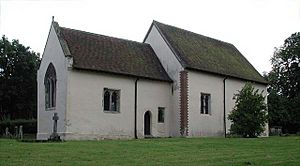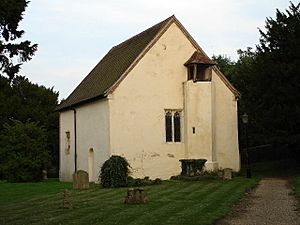Church of St Margaret of Antioch, Bygrave facts for kids
Quick facts for kids Church of St Margaret of Antioch |
|
|---|---|

Church of St Margaret of Antioch, Bygrave
|
|
| 52°00′33″N 0°09′24″W / 52.00919°N 0.15678°W | |
| Location | Bygrave, Hertfordshire |
| Country | England |
| Denomination | Anglican |
| History | |
| Status | Parish church |
| Dedication | St Margaret of Antioch |
| Architecture | |
| Functional status | Active |
| Heritage designation | Grade II* |
| Designated | 1968 |
| Years built | 12th to 15th century |
| Specifications | |
| Nave width | 20 feet 6 inches (6.25 m) |
| Materials | Clunch, brick, flint |
The Church of St Margaret of Antioch is an old and beautiful church in the village of Bygrave, Hertfordshire, England. It's an Anglican church, which means it belongs to the Church of England. The church is named after Saint Margaret of Antioch. It's so special that it's been a Grade II* listed building since 1968, meaning it's a very important historical site. It is part of the Diocese of St Albans.
Contents
A Look Inside the Church
The church building has a long history. People have been building on this spot since at least Saxon times, between the 8th and 10th centuries. During digs in 1993, archaeologists found pieces of Roman pottery. This shows that people lived here even before the church was built.
The church walls are made from a type of stone called clunch, mixed with brick and flint. The oldest part of the church is the nave, which was built in the 12th century. The chancel was added later, in the 14th century. The tall tower, called a west turret, was built in the 15th century. At that time, some windows were changed, and a special staircase for the rood screen was added.
Interesting Features and Art
Inside the church, you can find many old and unique features.
- Ancient Games: Look closely at the frames of the chancel windows. You might spot carvings of an old game called nine men's morris!
- Wall Paintings: There are small pieces of wall paintings on the west and north chancel walls. These paintings are very old, dating back to the 14th century.
- Windows: The nave has windows on its north, south, and west sides. The glass in these windows is modern. One special window is the stained glass Millennium Window, created in 2001 by Michael Lassen.
- Doorways: The north doorway of the church is now blocked up. The south doorway is from the 12th century, but it has been repaired quite a bit over the years. The porch at the south entrance was added in the 18th century.
- Bell: A small, semi-octagonal tower on the west wall leads to the church bell. This bell is quite old, dating back to 1718.
Special Items and Furniture
The church is home to several historical pieces of furniture.
- Baptismal Font: The baptismal font is where babies are baptized. This one is octagonal (eight-sided) and dates from the 15th century. It stands on a square base. The sides of the font are carved with symbols of the Passion of Christ. Around the stem, you can see angels holding shields. The font's wooden cover is from the 18th century.
- Rood Screen: The rood screen is a decorative screen that separates the nave from the chancel. This screen is from the 15th century. It has a carving of the Royal Arms on its top edge, which dates to the late 17th century.
- Altar and Rails: The altar and the communion rails, where people receive communion, are from the 17th century.
- Seating: Some of the wooden benches have special carvings called poppy heads from the 15th century. There are also other plain old seats.
- Pulpit: The pulpit, where the priest gives sermons, is mostly Victorian. However, it includes older panels from the 15th century. Attached to it is a wrought-iron stand from the 17th century, which once held an hour-glass.
Notable People and Visiting
A famous person who used to be a rector (a type of priest) at this church was George Coke. He later became the Bishop of Hereford.
Today, the Church of St Margaret of Antioch is open on weekends. If you want to visit, you can get the key from the churchwardens.


